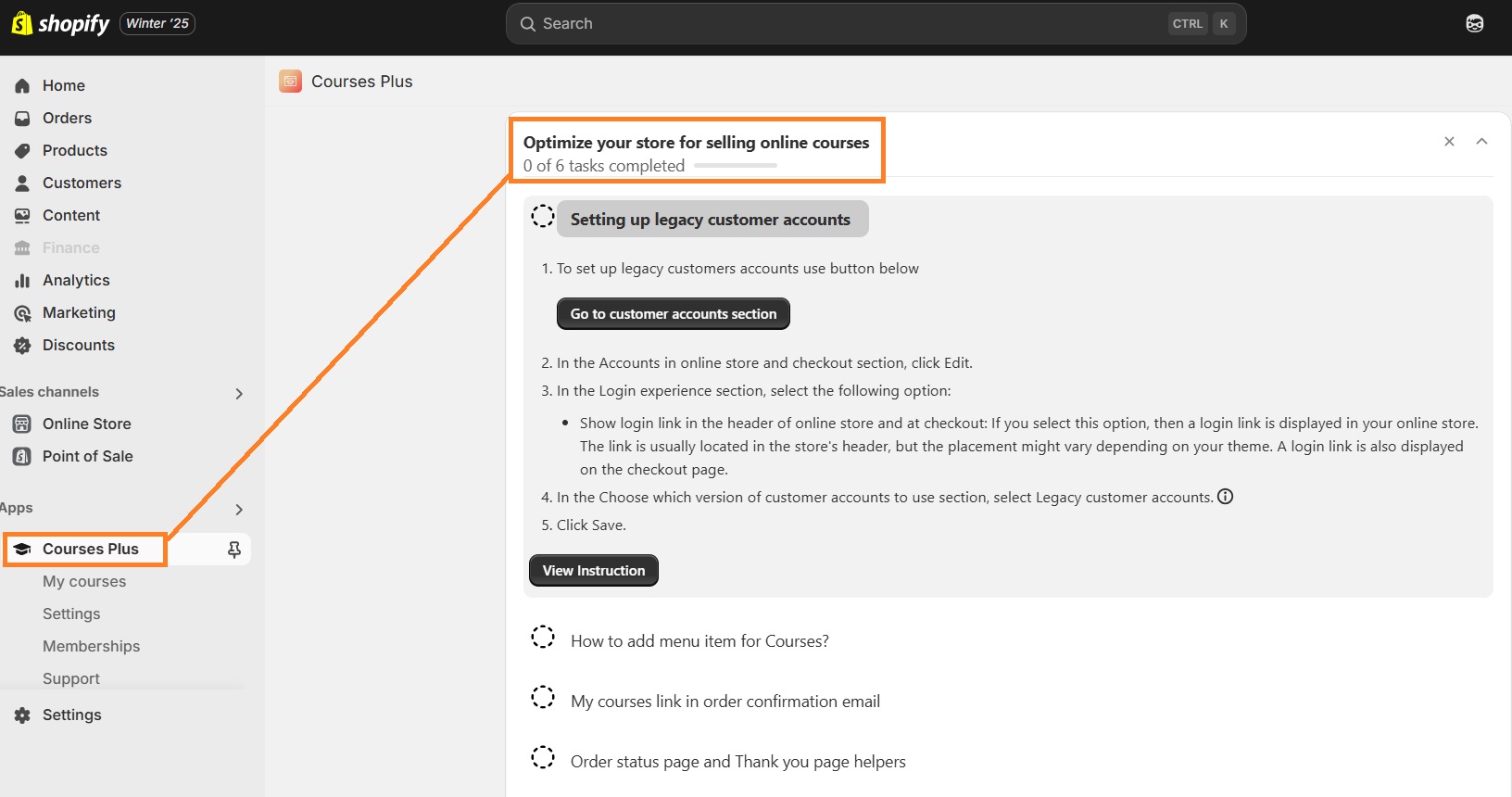In case you were wondering "Can you sell courses on Shopify", the answer is – absolutely yes, you can sell courses on Shopify! Although built as an eCommerce platform, as a course creator, you can leverage versatile Shopify functionality and become one of many successful Shopify businesses that don’t sell physical items.
Selling courses on Shopify is an excellent way to monetize your knowledge, especially now that the number of people working and studying remotely is increasing. What’s also great is that there’s no one strict method to do that, as you can sell Shopify courses in a few different ways. For example, you can use one of the best Shopify apps that specialize in online courses businesses.
However, in this article, we will tell you how to sell courses on Shopify following more than one practice. Not less important will be a step-by-step guide on selling Shopify courses and tips for running and promoting your online course store successfully.
4 ways to sell online courses with Shopify
You can sell online courses with Shopify in 4 most popular ways:
- Using a dedicated Shopify app
- Selling with restricted site access
- Selling access to live workshops as products
- Integrating with another course hosting platform
Each method works for different needs and comes with individual perks or drawbacks. However, every way to sell courses on Shopify is beginner-friendly; hence, you only need to walk through them below and choose the one that suits you most.
1. Use a specialized Shopify app
Using a specialized Shopify app to sell online courses is a user-friendly and time-saving way to monetize your knowledge. The most reputable Shopify online course apps allow you not only to create classes but also to add various assessments, monitor your learners’ progress, generate PDF certificates, and more.
Shopify has one of the most extensive app stores and it’s no different with the selection of seemingly good apps for selling courses. Yet, many of them lack important functionalities, making it complicated to start sharing your knowledge with students. Therefore, you must look for applications that offer all the features you may need, are easy to use, and aren’t overpriced.
Some of the top Shopify apps for online courses are:
- Courses Plus (From free to $199.99/month)
- Tevello Courses (From free to $19.99/month)
- Inflowkit Membership & Courses (From free to $129.99/month)
This is how to use a specialized Shopify app to sell an online course:
1. Create or sign in to your Shopify account.
2. Choose the application that works with online courses. For this example, we chose to use Courses Plus.
3. Select the subscription plan and install the app on your Shopify store.
4. Head to the Courses Plus dashboard and get instructions on how to start selling online courses.
6. Preview and publish your course on a store.
Selling online courses with the help of a dedicated Shopify app provides you with many benefits. It’s a time-saving method, as you receive a handful of automated features. You also receive built-in features for running your business and better student engagement. However, you must choose the app wisely, as some of them may be dysfunctional and waste your time.
Pros of using a specialized Shopify app:
- Most Shopify apps are user-friendly ensuring effortless integration
- Robust apps include various features for creating a powerful online course
- You don’t need to share your revenue with the app constantly
- You can use a free trial to test the app and see if you like it
Cons of using a specialized Shopify app:
- Possible technical issues
- Limited course management compared to a dedicated learning management system
- Analytics may be inaccurate
2. Sell with restricted site access
Selling online courses on Shopify with restricted site access is one of the easiest ways to earn from sharing your knowledge with others. Using this method, your online course will be available only for those site visitors who have a password to unlock it.
This way, you can create pages or blog posts that can contain images, videos, or audio tracks. However, it’s important to ensure visuals are well-optimized and mobile-responsive, as it allows your online course to be accessible at all times.
The method is simple but also comes with a handful of limitations. To password-protect your course pages or interact better with your students, you will need to use third-party Shopify applications.
Pros of selling online courses with restricted site access:
- It’s a beginner-friendly method regarding the setup and the budget
- You can adjust the functionality of a website based on your needs
- It allows you to test the demand for your online course before investing a lot
Cons of selling online courses with restricted site access:
- Natively, this method is very limited with functions
- Driving traffic and managing the marketing strategy depends fully on you
- Selling multiple courses simultaneously is complicated
3. Sell access to live workshops as products
Although primarily Shopify was built to create online stores that sell physical items, now it perfectly works for selling services too. That being said, you can sell access to live workshops as products right on your Shopify store.
If you want to offer a live workshop as a product on your Shopify store, there are a few things you need to do. First, write a detailed and informative description of the workshop. Second, optimize the metadata to make it easier for people to find the workshop. Finally, set up an email with the access link for the workshop that the user will receive after the payment.
Pros of selling live workshops as products
- Adding online courses to your store as products is easy
- You don’t need to build a separate website to sell workshops
- The method requires low investment
Cons of selling live workshops as products
- You will need to work on promoting live workshops
- You may need to install additional apps for customer support, video calls, and scheduling
- It’s difficult to ensure good video and sound quality throughout the workshop
4. Integrate with another course hosting platform
The demand for 24/7 virtually accessible knowledge is only growing. As a result, there are many course hosting platforms that you can use to sell your online course. What’s great about them is that they already have large audiences and some of them are also compatible with Shopify.
When it comes to course hosting platforms, there are both free and paid options available. The cost of paid platforms can be around $39 per month. However, the most important thing to consider is the functionality that you need for your online course. We suggest you check supported content formats, editing features, support for assessments, as well as marketing and payment features.
Below, you can find the top course hosting platforms that work with Shopify payments:
- LearnWorlds (from $29/month)
- Thinkific (from free to $149/month)
- Avizr (from $39/month)
- TalentLMS (from free to $459/month)
Overall, this is the most popular way to sell courses online. The best part about it is that you don’t have to work completely on your own to attract some amount of the student base. However, it doesn’t mean that you don’t need to work on promoting your online course at all.
Pros of integrating with another course hosting platform
- There are always large user bases
- It’s a dedicated learning platform where all you need to do is to enable the Shopify payments functionality
- Hosting an online course on a popular platform increases the reliability of your course
- The platform takes care of technical aspects for you
Cons of integrating with another course hosting platform
- Many course hosting services charge fees or take some percentage of your revenue
- The marketplace may be very competitive, depending on your course topic
- The engagement options are limited
How to create an online course on Shopify?
Creating an online course on Shopify involves exploring the course concept you want to deliver, setting up the content, organizing it for sales, and configuring specific Shopify settings. In a nutshell, the process requires you to be creative, analytic, and have basic technical knowledge.
Here’s a quick guide to start selling online courses on Shopify:
1. Set up a Shopify store or log in to the one you already have created.
2. Prepare the content for the course you will be selling on Shopify.
3. Choose one of the options to sell the course with Shopify.
4. Write the course description and optimize it for SEO.
5. Set the price of the course and publish it on your Shopify store.
Make sure your online course on Shopify is successful
Once you learn that you can sell online courses on Shopify, jumping straight to multiple simultaneous tasks isn’t the best way to go. Releasing an online course puts you in the position of an expert; therefore, you should do everything to make it inspiring and successful.
By walking through the tasks listed below, you will be ready to run a profitable online course on Shopify and continue growing yourself as a professional in the field.
Properly plan your course
Properly planning a course to sell doesn’t mean the same to all, yet, there are crucial steps to take that allow you to move on with developing and preparing the course for your customers.
- Researching the field
- Analyzing the audience
- Choosing the course format
So, we are pointing out the main three stages of course planning, which is about choosing the subject that sells and learning what your potential customers need. According to the research, around 42% of small businesses fail because there’s no market for the products they sell. The other 14% don’t succeed, as they tend to ignore their audience.
First of all, there are various reasons why people buy courses. It can be a desire to gain knowledge for the current or future work, get certified in a subject, or simply improve their knowledge, among others. However, it seems that most people are interested in purchasing online courses on Shopify due to better career prospects. As a result, your responsibility is to regularly monitor the list of jobs that are in high demand.
Researching the topic isn’t all, as you also need to put yourself in the customer’s shoes. This way, you will be able to learn what people with zero or basic knowledge of the topic need to hear. You will also get the idea of what are the biggest challenges they may come across, what are the goals they need to achieve, and how to make them buy your courses.
Finally, selecting your course format will determine how much content it will carry, what audience it will target, and the revenue it may collect. There are three main online course formats: mini-courses (under $100), multi-day courses (from $250 to $2,000), and masterclasses (from $300 to $5,000). If you’re new to creating online courses with Shopify, it’s best to select mini-courses not to underdo the effectiveness of the classes.
Online course selling tips
Coming up with a well-thought-out strategy to attract the audience and make a profit is essential if you want to monetize your knowledge efficiently. These are the main things to consider in order to sell online courses on Shopify or other platforms successfully:
- Select the platform to sell and host online courses. Shopify is one of the most comfortable platforms to sell your online courses. However, it’s a good practice to host them on multiple platforms, as you can grow your audience more easily. That said, there are three types of platforms for selling online courses – it’s standalone platforms, e-commerce platforms plug-ins/themes, and all-in-one platforms. For beginners, we recommend going with all-in-one platforms first, like Coursera or Udemy.
- Decide on the price of your online course. Questioning how much you should charge for your course is one of the most common questions beginning course creators have. At first, the price may fluctuate till you find the best fit. But to find it out more quickly, you should evaluate the amount of time you spent creating the course, the competitor pricing, and your targeted audience’s potential budget.
- Pre-sell your online courses. Another effective strategy is pre-selling your courses. Even if your online course still needs to be fully prepared, it is important to gather an audience before its official release. This will help you determine the level of interest in your course and also fund your creation process. That being said, to pre-sell your course, you need to have at least the title, topic, and outline of the course so your customers get an idea of your offer. It’s also recommended to set the goal of a pre-sale, for instance, the expected revenue or the number of registered students.
Promoting your online course
Creating an online course is only one side of the business to make it work – now, it’s time to make it visible by applying an effective marketing strategy. One of the first steps to take is optimizing the course for search engines (SEO.)
Starting from the course content or blog posts, and continuing with the SEO metadata – inserting targeted keywords will help you make the course more visible online and attract more students.
Make sure your important pages are optimized for SEO, from metadata to speed.
Use TinyIMG appNot less important is to empower social media. Various platforms can work for both free and paid online course promotions. Start building the audience there even before making your course available on the market. And, with time, ensure the content there dynamically evolves with the growing number of followers.
One more effective way to increase traffic to your website or online course is by producing newsletters and guest blogging on field websites. This way, you can use more high-ranking keywords and even get a backlink or two from credible sources.
Collecting students' testimonials
Every successful business needs to build a base of reliability that comes from nothing else but the customers. You, as a course creator, should collect testimonials and use them as social proof on your website and other platforms where you usually promote your online course.
To collect testimonials from your current or past learners, you can either passively wait for them to accept your invitation to leave feedback, or you can encourage them by running a reward program. For example, you can offer your students a discount on a course in exchange for a testimonial.
You may also register your website on dedicated review platforms, such as Trustpilot, where potential clients can search for third-party reviews. Although this method doesn’t guarantee only applauses, it’s important to have unbiased feedback on your course to reflect your credibility.
Conclusion
Creating an online course to sell on Shopify takes lots of time and effort. However, with the help of modern technology, you can continue to sell your online course to thousands of people without having to individually interact with them while still making a profit.
Luckily enough, there are different ways to sell an online course on Shopify. The top options include using a dedicated application, selling with restricted site access, selling workshops as products, and integrating with a specialized course hosting platform.
But creating and publishing an online course isn’t all, as you also have to make it successful and noticeable. Properly planning your course will help you understand your competitors and the potential audience. Meanwhile, a good marketing strategy and social proof are essential to attract a larger customer base.
Curious to read more? Check out these articles:







